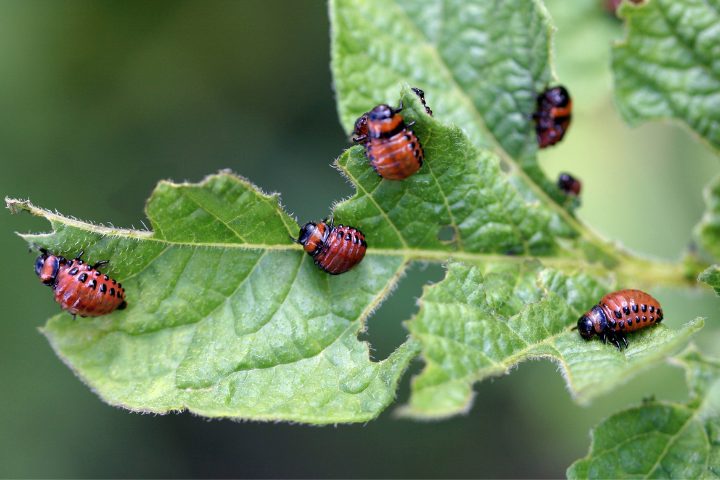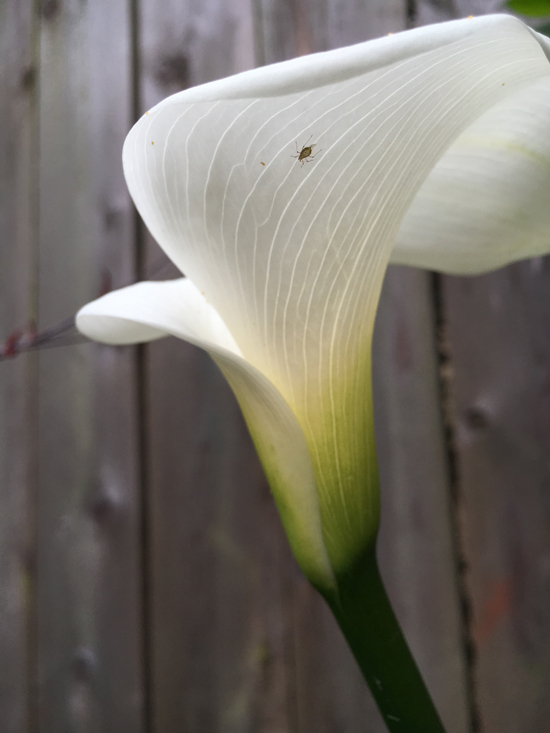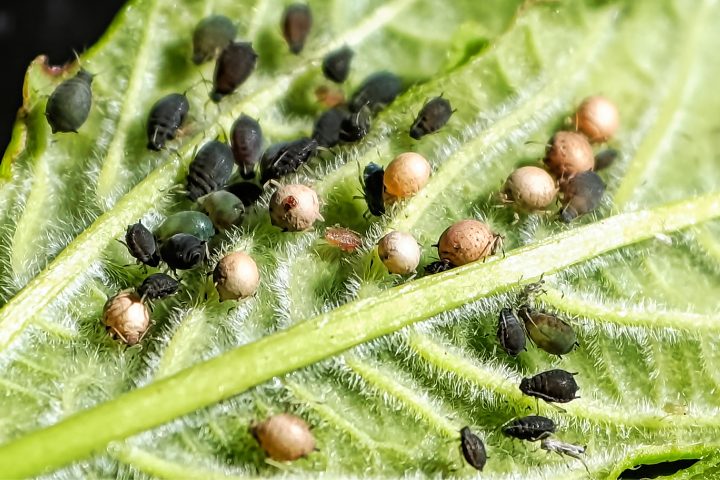An aphid infestation is nothing to joke around; it can destroy a garden very quickly. If you want to understand how aphids attack your plants, it is important to know the answer to: what do aphids eat?
If you take care of plants in your daily lives, you do not need any introduction to an aphid infestation.
Aphids often feed on soft plants that they can easily puncture and consume the plant sap, the main source of nutrition for them.
To deal with aphids, you need to know how these insects do their damage, what their food chain looks like, and how their life cycle works. In this blog, we will introduce all these things!

What Plants Do Aphids Eat?
Apart from 1-2% of the aphid species, most choose only one host plant to eat, and they are loyal to that plant. Due to this reason, they are called monophagous pests.
Some common plants that aphids can infest are crops like corn and cabbage. Melons, underground vegetables, and ornamental plants are also good targets for aphids.
About 1-2% of species of aphids, such as the green peach aphids, can derive nutrition from multiple types of plants.
In most cases, aphids become natural enemies of plants with soft stems from where they can extract the sap. This includes flowering plants, fruit trees, and vines.
Aphids may attack different plant areas, like stems, leaves, and roots. Root aphids live in the soil around the plant instead of living on the plant itself.
How Do Aphids Eat?
Aphids find host plants using their sense of smell and touch, using their antennas. Once they have found a good target, they inject saliva into the stems, leaves, or roots to make it easy to feed.
The insects use needle-like mouthparts known as stylets into the softer parts of the plant to extract sap from the host plants.
First, they attack the xylem of the plant and then the phloem tissue, where they find the sap.

What Nutrients Do Aphids Get From Plant Sap?
Plant sap is one of the main food sources for aphids. Plant sap is a rich source of sugar, nitrogen, and other nutrients.
Aphids are mostly interested in the nitrogen available in the plant sap. The sap also contains water.
The sugar is something that comes along with it, and they just carry it around in the form of honeydew and excrete it out later on.
Most aphid populations are found on plants that are known to have a high content of nitrogen. They are also likely to look out for plants that have a high moisture content.
How Some Bacteria Help Aphids Process The Sap
Plant sap gives aphids nitrogen, sugar, and moisture. But one thing that is not directly available in sap is amino acids.
Aphids have a symbiotic relationship with a bacteria called Buchnera Aphidicola that helps them break down plant sap into multiple amino acids inside the insects’ bodies.
Aphids don’t just feed on plant sap – they end up inadvertently weakening the plant they feed on.
Extracting the sap makes the plant susceptible to disease. It can also cause deformities in new growth.
Moreover, the sticky honeydew they secrete can create mold and attract other insects to the infected plant.
How Ants and Aphids Benefit Each Other
This heading might seem out of place in an article about what aphids eat. But hold on, we assure you, this is relevant!
Ants “milk” aphids for the honeydew that they carry around. Ants behave as bottom feeders to aphids, using them as a secondary source of nutrition.
Interestingly, even though ants are predators of most other bugs, they don’t attack aphids as long as they are extracting honeydew.
In fact, ants become protectors of these little creatures, herding them and keeping them safe from other predators. In this way, the two have a symbiotic relationship with each other.

How Aphids Harm Plants in Many Ways
Aphid infestations are terrible for plants. It is not just that they take out the plant sap – they cause a lot of damage in many ways.
They are one of the worst pest infestations that can occur to your plants, and knowing what they do can help you prepare for an attack.
We have already talked about plant sap as one of the main diets of aphids. But what does this mean for your plant?
Reduction in Nutrients
Plant sap consists of sugar and additional nutrients required for a plant’s growth. When aphids take away these nutrients, you will notice your plant turning from green to yellow and then brown, showing signs of nutrient deficiency. The plant loses its nutrients and can ultimately die an early death.
Transmission of Disease
Aphids carry plant viruses. When an aphid pierces into a plant to extract nutrients, it can transmit viruses that affect the plant’s health.
If the aphids start multiplying, the aphid eggs also become carriers of the same disease, affecting more plants. The infected plants are more likely to die from the virus than from the aphid infestation.
Toxic Saliva
Just like an insect’s sting is harmful to a human being, an aphid’s sting leaves the plant vulnerable.
Some aphid species have toxins in their saliva, and when they pierce a plant, the toxin gets transmitted. The main sign of toxic saliva from aphids is the yellowing of leaves in a plant.
Development of Sooty Mold
Patches of sooty mold around leaves and stems are another marker of aphid infestation. The mold forms because of the honeydew that these bugs secrete all over the plant.
As unpleasant as it is to look at, this mold is a fungus that can be a health hazard for crops. Moreover, it attracts other pests to the crop.

Frequently Asked Questions
Should I kill aphids?
Yes, if you find aphids infesting your plants, it is best to get rid of them quickly. These pests can reproduce at lightning speed and in no time destroy the whole garden.
Spraying your garden with insecticidal soap, releasing beneficial insects such as lacewings and beetles, and regular pruning of infested leaves are the best ways of taking care of aphids.
What do aphids turn into?
Aphids are adult pests; they are not larvae. Most species of aphids overwinter. Female aphids leave their eggs on the leaves of their host plants.
When their eggs hatch, they are called nymphs. The nymphs do not have a pupal stage and directly grow into adult aphids.
Aphids shed their exoskeletons four or five times, like most other insects (called molting).
Do banana peels keep aphids away?
Yes, banana peels are a good pest repellent that can work on aphids as well. You can cut up banana peels and bury them about two inches deep in the soil of plants that are prone to infestations. Most aphids will redirect themselves to the peel, which will protect your plants.
Can aphids bite you?
No, aphids are not capable of biting humans. They have sharp mouthpieces which they use on plants, but those cannot cause any harm to animals or humans.
Few species, like the pea aphid and gall-forming aphids, can bite humans and cause minor skin problems.
Final Words
Aphids are not like other common garden insects that you can leave alone. You must control these pests at the first sign to avoid as much damage as possible.
The best idea to tackle aphids is to spray soapy water using a spray bottle on the plants or else release aphid predators like ladybugs, lady beetles, parasitic wasps and green lacewings in your garden. Thank you for reading!
Reader Emails
Over the years, our readers have sent us several emails on this topic. Please go through them below.
Letter 1 – Aphid on a Calla Lily
 Subject: Tick-like bug
Subject: Tick-like bug
Location: San Francisco, CA
March 3, 2016 6:46 pm
Hey The Bugman,
Wondering if you can help me id this bug. Sorry, it’s not the best quality pic. One pic is up close, the other is so that you can get an idea of the scale. I found the bug in my back yard on a calla lily. You’ll also see that there’s a smaller bug near it. I’m most curious about the larger bug.
Any ideas?
Thanks!
Signature: StormMiguel

Aphid on a Calla Lily
Dear StormMiguel,
This is an Aphid and we do not believe its diet, which consists of sucking fluids from plants, is limited to the calla lily. The other, smaller insect, appears to be a Psocid.

Aphid and possible Psocid
Thank you so much! I never would have guessed it was an aphid – as big as it was. I was worried it might be a tick.
I will make a donation to your site. Sorry that I can only afford $10 at this time.
Your help is greatly appreciated!
Letter 2 – Podocarpus Aphids
 unidentified blue bug
unidentified blue bug
Location: Southern California
March 27, 2011 6:56 pm
I was curious if you could help me in identifying this bug, if it is one. I’m gonna make a guess as to it being an aphid of some sort or related to them, but I am no entomologist. They are all over the leaves of my hedge. I would really be grateful for the help.
Signature: Curiously Intruiged

Podocarpus Aphids
Hi Curiously Intruiged (Intrigued?),
You are correct. These are Aphids. We have similar Aphids on the collard greens in the vegetable patch of our Mt. Washington, Los Angeles garden, though we have not tried to correctly identify the species.
Update:
Buglady just provided a comment that these are Podocarpus Aphids, Neophyllaphis podocarpi, and BugGuide has a few images of the species.
Thank you so much. (And yes i meant intrigued, damn dyslexia haha.)
Letter 3 – Black Aphids
 Subject: Tiny black insects on flower bud
Subject: Tiny black insects on flower bud
Location: Stockton, CA
March 26, 2014 1:01 pm
It started raining recently, and I just noticed these small black bugs on a flower bud sprouting from the succulent plant on my balcony. I included a close-up and a shot from farther back for size perspective. They don’t seem to move much, and they appear to be less than 1 mm in length. They’re kinda cool looking. What are they??
Signature: Bug-Curious

Black Aphids
Dear Bug-Curious,
You have Aphids and they feed by sucking the nutritious fluids from plants, so though they look cool, they are injurious to your plant. There is a similar photo on Succulents and More.
Letter 4 – Oleander Aphid
 Subject: These guys fell out of my hair
Subject: These guys fell out of my hair
Location: Caledon, Ontario, Canada
December 21, 2014 9:54 am
Hello there, I have spent all morning scouring the internet to no avail.
What do you think these guys are, they fell out of my hair easily this morning. I have been renovating the basement, and sticking my head up into the cobwebs in the ceiling, but we also have a six-month old boy, a dog, cat and two horses. The closest I cam was a spider beetle, but those posterior black stubs are throwing me off. Just want to make sure that they are not ticks or bed bugs.
The body/thorax is around 2 mm long, and both images are the same scale.
Signature: CP

Aphid
Dear CP,
This is an Aphid, a common pest on many cultivated and wild plants. Do you have a live Christmas tree in the house? Living trees brought indoors often carry unwelcome insect visitors, and Aphids coming indoors on Christmas trees are seasonal holiday sightings for our site.
Hi Daniel, thank you so much for the quick response! About 30 mins after I sent you the message, I realized that I had moved a house plant into another room…an OLEANDER…so guess what I looked up next! Big sigh of relief! The plant was covered in them!
Great site, you are one of a kind and thank you so much for the help!
Thanks for that update CP. We did not think this looked like a Giant Conifer Aphid. Oleander Aphids are generally yellow in color.
It wasn’t until I looked up the milkweed/oleander aphid that I realized it was a juvenile. Amazing little creatures; what would be your theory on how they ended up in my house, in the middle of winter, a thousand kilometers north of the natural range of oleander plants?
I suppose that phenomenon is similar to when the red Asiatic lily beetles appear in mid-summer to munch on – you guessed it – my Asiatic lilies.
The life of a human is so busy and hectic these days, those little natural details just get swept away in the madness…almost impossible to spot with the untrained eye.
Good to know there are still people out there who care about the heaviest portion of the world’s total biomass.
Colin
Hello again Colin,
The Oleander Aphid or Milkweed Aphid, Aphis nerii, feeds on plants other than oleander and milkweed that contain milky sap. Our own potted Hoya plants are prone to infestations, especially on the new growth. People who live in areas with freezing winter climates often grow semitropical plants like your own oleander, and they are frequently taken outdoors during the warm summer months when they might become host to a single female Aphid that will reproduce indoors under favorable conditions. According to BugGuide, the range of the Oleander Aphid included Maine, and though there are no Canadian reports, we can assure you that insects do not respect international borders. It is also possible that a recently acquired plant was purchased with a preexisting population of Aphids that initially escaped notice, but eventually multiplied.
Letter 5 – Aphid Infestation
 Aphids?
Aphids?
Hi Daniel and Lisa,
Found these on my roses… my best guess is that they are aphids. They are on practically every branch tip of my roses. Grrrr. I will try hosing them off with a strong spray, and then will try the soapy water you recommended in one of your aphid letters. Wish me luck!
Yvonne
Barrie , Ontario

Hi Yvonne,
That is some Aphid infestation you have there. We have had some springs when we have a similar situation on our own rose bushes. The hose works very well because many of the young aphids are flightless and cnnot get back to the young tender rose shoots once they have been knocked to the ground. We also have problems with yellow aphids with black legs on our hoyas.
Letter 6 – Aphids
 Great site!
Great site!
I have been searching for hours to try to find out what this bug is that has taken over one of my butterfly weed plants. Should I worry about it infesting the rest of my garden? I was reading some of the other posts and this is such a great resource for curious folks like me! Hope you can help me identify this bug.
Thanks, Timlie Reis
Gulf Coast Mississippi


Hi Timlie,
You have Aphids. These pests can easily infest many types of plants. You have some winged sexual adults which mate in the typical manner. They then produce generations of female aphids which do not need a mate, but can give live birth without the help of a male. The aphids then become very plentiful. They damage plants by sucking the juices from new growth. They are uaually very host plant specific but other aphids are more general feeders. You can easily eliminate them or at least contro them with diligent daily hosing. Use a strong spray to wash them away. You can also spray them with soapy water. It clogs their breathing aparatus and causes them to drown.
This is an additional comment relating to the milkweed in Temile’s photo. It was a milkweed plant which is the host plant for a number of butterflies, including monarchs. Your advice about using soapy water to rid it of aphids was correct but would also kill off butterfly eggs, caterpillars & chrysalises. A strong stream of water will also wash off eggs, caterpillars and possibly chrysalises. There is hope, however! The natural predator for the aphids is the lady beetle. My experience is that lady beetles usually come along about 2 weeks after the start of an aphid infestation. If the infestation is not overwhelming I usually leave the aphids for the lady beetles. The lady beetles may also lay eggs and the larva will devour the aphids. But if my plants are overwhelmed by aphids or there are caterpillars feeding which need the leaves right away I control by carefully hand-squishing aphids (while they’re still on the stems & leaves) until the lady beetles show up. Yech! But having monarchs around the yard all year is worth it. You do a fabulous job!
Warmly,
Kathleen Scott
The post What Do Aphids Eat? Best Answer appeared first on What's That Bug?.








 Subject: Unknown Bug on maple leaves
Subject: Unknown Bug on maple leaves


 Subject: Yellow Bug
Subject: Yellow Bug
 Bug on my Gay Butterflies
Bug on my Gay Butterflies






 Mini Bug Super Highway on my Garden Hose
Mini Bug Super Highway on my Garden Hose
 On hyacinth bean vine
On hyacinth bean vine
 Subject: Weed brownies g
Subject: Weed brownies g




 Subject: Tick-like bug
Subject: Tick-like bug

 unidentified blue bug
unidentified blue bug
 Subject: Tiny black insects on flower bud
Subject: Tiny black insects on flower bud
 Subject: These guys fell out of my hair
Subject: These guys fell out of my hair
 Aphids?
Aphids?
 Great site!
Great site!
